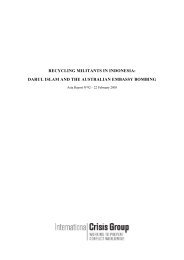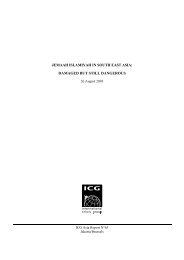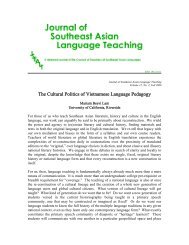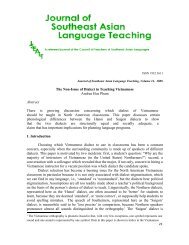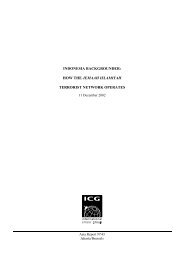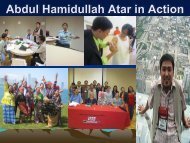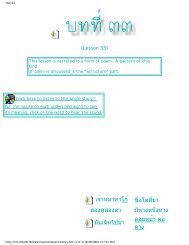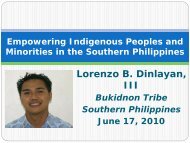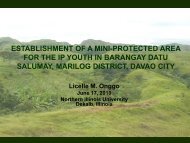Introduction - SEAsite - Northern Illinois University
Introduction - SEAsite - Northern Illinois University
Introduction - SEAsite - Northern Illinois University
You also want an ePaper? Increase the reach of your titles
YUMPU automatically turns print PDFs into web optimized ePapers that Google loves.
Prentation Abstracts<br />
Ministry of Health through its Traditional Medicine Research Center. One question<br />
this project is currently investigating is whether geographic location or cultural<br />
heritage has the greatest influence on levels of medicinal plant knowledge.<br />
Results from this study are expected to demonstrate whether cultures living in<br />
similar regions of the country possess similar levels of medicinal plant knowledge<br />
or if cultural traditions, rather than geographic location, determine how much medicinal<br />
plant knowledge a culture possesses.<br />
Viengsay S. Luangkhot<br />
Media in the Lao PDR: Post Chintanakane Mai Challenges<br />
Director, Lao Service, Radio Free Asia, Washington, D.C.<br />
A communist one-party state since 1975, the Lao PDR does not tolerate any<br />
dissension. It views the media as a tool for the Lao communist party, with four<br />
main objectives:<br />
1. Disseminate the policies of the party/state<br />
2. Reform people’s minds, and old policies<br />
3. Fight the enemies’ “propaganda”<br />
4. Attack the opposition.<br />
In 1986, when then president Kaysone Phomvihane adopted the “Chintanakane<br />
Mai” or the theory of economic liberalization, the Lao PDR faced new<br />
challenges: How to open the country to market economy, while maintaining the lid<br />
on the socio-political aspects.<br />
The challenge has increased in intensity during recent years, as the Lao PDR<br />
plays a more active role in the regional scene, and depends heavily on international<br />
assistance for its development.<br />
Kristin V. Lundberg<br />
Women, Weaving, and Well-Being: The Social<br />
Reproduction of Health in Laos<br />
<strong>University</strong> of Kansas, Kansas<br />
Health is more than a biological phenomenon and demographic indicators. It<br />
exists in synergistic processes between biological actions and social constructs. To<br />
a large degree, health occurs because of the interactions of people and their commitment<br />
to relationships, institutions, and productive means, resources affected<br />
by historical, ideological, political, social, and economic forces. The interconnectedness<br />
of social determinants and biology coalesce in the concept of a social<br />
reproduction of health where the focus is on how health is created, maintained, and<br />
reproduced. Women weavers and their families in Laos provided a microcosm by<br />
which to study the social reproduction of health because of particular conventional<br />
cultural practices connected to the making of textiles within a country striving to<br />
prosper and overcome least-developed status.<br />
Marlys A. Macken, Ph.D.<br />
Acoustic Phonetics of Lao Tones<br />
Professor – Department of Linguistics, <strong>University</strong> of Wisconsin-Madison,<br />
Wisconsin<br />
The tones of Tai languages are typically studied within the historical model<br />
and method of Gedney (1964), using a basic twenty word word-list for twenty<br />
categories that vary by initial consonant, and Proto-Tai tones (*A,*B, and *C)<br />
and syllable type (smooth versus checked syllable). Synchronic descriptions of<br />
Lao tones posit five or six main tones (in smooth syllables) with considerable differences<br />
by dialect and in the nature of each tonal phoneme (e.g. rising, falling,<br />
low, high, etc.). This paper presents acoustic phonetic data for the Lao tones in<br />
two Lao dialects, the Central Vientiane dialect and the Southern dialect as spoken<br />
in Savannakhet. Data include multiple tokens of at least five words per Gedney<br />
category, words spoken in both isolation and in sentence frame, and native speaker<br />
judgments about phonemic contrast and where tones in particular words are the<br />
same or different. Results include (i) cross-dialect similarities in the phonological<br />
factoring of the Gedney 20 category proto system; (ii) differences between dialect<br />
in number of the tone phonemes (five tone phonemes in the Central dialect (as per<br />
Crisfield and Hartmann 2002, Enfield 2000, and Brown 1965, among others), five<br />
tone phonemes in the Savannakhet Southern dialect that are different from the<br />
five tone phonemes in Vientianne and different from the six tone phonemes for<br />
the Southern dialect as spoken further south of Savannakhet in Pakse (a not surprising<br />
variation given other reports); (iii) differences in the phonological shape<br />
of the tone phonemes; and (iv) within category acoustic differences that provide<br />
dramatic evidence of the underlying historical development and the synchronic<br />
dialect system from <strong>Northern</strong> to Southern Laos.<br />
Ven. Dussdi Manisaeng listed name shortened here<br />
Viewing Laos through Buddhism: Yesterday, Today and Tomorrow<br />
Wat Lao Wichita Monastery, Lao Buddhist Association of Kansas, Kansas<br />
• The meaning and main ideas of Buddhism, and the influences and an important<br />
of Buddhism for the people of Laos.<br />
• Buddhism earlier came to the Lane Xang Kingdom.The King Fa Ngum<br />
brought over the Politics of period and political authority along with Buddhist<br />
moral rule.<br />
• To inform you about Buddhism in primary age, middle and final ages of the<br />
Lane Xang Kingdom.<br />
• Buddhism during the Lao Royal Kingdom under the rule of other colonies.<br />
Buddhism, Influence, Function and Important to the society of Lao today.<br />
• How is going on in the future about Buddhism in Laos.<br />
• In conclusion: would like to inform you about Lao Sangha ruler law 1998I<br />
and the former leaders of the Lao Sangha.<br />
Justin McDaniel, Ph.D.<br />
Buddhist Pedagogy in Laos: Past and Present<br />
Dept. of Religious Studies, <strong>University</strong> of California, Riverside, California<br />
Laos has been generally seen as a place of little innovation and development<br />
in terms of Buddhist texts and textuality. However, many have overlooked the contribution<br />
Lao Buddhist intellectuals have made to the development of new genres<br />
of Buddhist literature especially in regards to pedagogical texts. This paper will<br />
examine some examples of palm-leaf manuscripts used for sermons and monastic<br />
instruction and then compare their pedagogical techniques and rhetorical style to<br />
modern Lao sermons (both oral and printed) and student guidebooks. The paper<br />
claims that there has been great continuity in Lao pedagogy from the sixteenth<br />
century to the present despite political, institutional, and economic shifts and disruptions.<br />
Dararat Matarikanon* and Yaowalak Apichatvullop**<br />
Historical Presentations in the Lao Texts: From<br />
the Independent to the Socialism Era<br />
*Associate Professor in History, Center for Research on Plurality in the Mekong<br />
Region, Khon Kaen <strong>University</strong>, Thailand<br />
**Assistant Professor in Sociology, Center for Research on Plurality in the Mekong<br />
Region, Khon Kaen <strong>University</strong>, Thailand<br />
This paper presents some preliminary findings from a research on Representations<br />
of Lao History in the Lao Texts: From the Period of Independent Era<br />
to the Establishment of the Lao People’s Democratic Republic ( 1954 – 1986 ).<br />
The study has confirmed the historical significance of the mentioned period, as<br />
it was shown that this was the time for national building after acquiring independence<br />
from France. The history of this period was constructed, and presented<br />
in chronological style, as influenced by chronological writings of the past. The<br />
content of the history mainly focused on the core institutions, namely the state,<br />
religion, and kingdom. At the same time, the presentations of history in the period<br />
after the political revolution in 1975 was very much influenced by Marxism.<br />
During this period, Laos was transformed into a socialist state with the country’s<br />
name changed from “ the Kingdom of Laos” to “the Lao People’s Democratic<br />
Republic”. The study found there had been efforts to build up nationalism through<br />
local texts. In other words, the historical reality as presented in the texts were<br />
reproduced by the nation – state, and was used as means to socialize the younger<br />
generations. Such history was the history of struggles, competition between the<br />
dominating powerful foreign countries and the Lao people, and the final liberation<br />
of the country. In these presentations of the struggles, the Lao history has provided<br />
space to describe the kings in the royal period, common peoples movements, and<br />
ethnic group relations. It also made reference to the countries that were involved in<br />
the internal struggles after the second World War. For example, many texts allow






